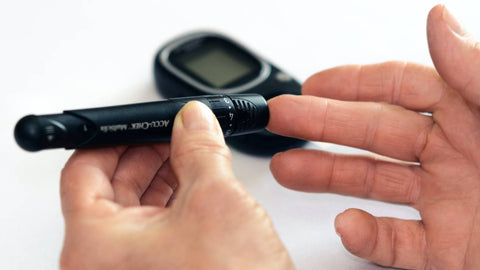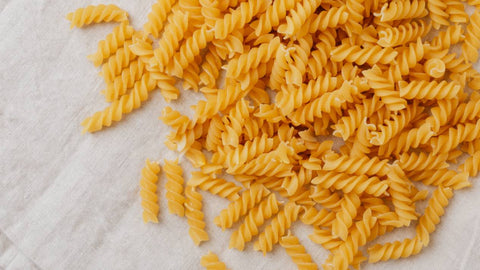Diabetes affects over 2.5 million Australians and is our fastest growing chronic condition.
By the time you finish reading this blog, another person will develop diabetes, this equates to 1 person every 5 minutes or 280 Australians per day. Diabetes is often called a silent disease as every person diagnosed with diabetes usually has a family member living with the condition too.
Although some of the risk factors for developing type two diabetes are out of our control such as age and family history, the good news is that there is a lot we can do when it comes to diet and lifestyle to help prevent, manage or even reverse this condition.
What is diabetes?
 When blood sugar levels rise, the pancreas releases a hormone called insulin. Insulin is like a key that helps glucose enter the cells of the body where it is used for energy. Glucose enters the cells of the body including muscles where it is used for energy. This lowers blood glucose levels as glucose leaves the blood to enter the body cells.
When blood sugar levels rise, the pancreas releases a hormone called insulin. Insulin is like a key that helps glucose enter the cells of the body where it is used for energy. Glucose enters the cells of the body including muscles where it is used for energy. This lowers blood glucose levels as glucose leaves the blood to enter the body cells.What are the risk factors?
- Have a family history of diabetes
- Have high blood pressure
- Have a history of heart disease or stroke
- Are physically inactive
- Are overweight (particularly when it sits around the midsection)
- Are >55 years of age
- Are >45 years of age and are overweight or have high blood pressure
- Are > 35 years of age and are of Aboriginal or Torres Strait Islander background or are from Pacific Island, Indian subcontinent or Chinese cultural background
- Have given birth to a child over 4.5kgs or had gestational diabetes (GDM) when pregnant
- Have depression
- Have Polycystic Ovarian Syndrome (PCOS).
How can diet and lifestyle help?
%20-%20Copy.jpg) Nutrition is recognised as an important component of managing diabetes and it is important that anyone who is diagnosed engages with a dietitian qualified in this area, the earlier the better. Lifestyle interventions that include diet and exercise have been shown to be effective in delaying the onset of type two diabetes and keeping blood sugar levels, cholesterol levels and blood pressure within normal ranges. In fact, research shows that working alongside a dietitian can:
Nutrition is recognised as an important component of managing diabetes and it is important that anyone who is diagnosed engages with a dietitian qualified in this area, the earlier the better. Lifestyle interventions that include diet and exercise have been shown to be effective in delaying the onset of type two diabetes and keeping blood sugar levels, cholesterol levels and blood pressure within normal ranges. In fact, research shows that working alongside a dietitian can:- Significantly improve blood sugar levels
- Potentially increase levels of good cholesterol (HDL)
- Potentially lower levels of bad cholesterol (LDL) and triglycerides
- Reduce blood pressure
What dietary patterns have been shown to increase the risk of developing type two diabetes?
- Red and processed meat e.g. ham, bacon, sausages
- Potatoes, particularly fried potato
- Sugar-sweetened beverages e.g. softdrinks, energy drinks
- Refined carbohydrates e.g. corn flakes, white bread, cakes, biscuits, saos
What diet and lifestyle changes should you make to prevent or manage type two diabetes?
Aim for a healthy weight
- Being overweight is one of the biggest risk factors for developing type two diabetes as ~80-90% of people with type two diabetes are overweight and have excess fat which compromises your body’s ability to balance its blood sugar levels
- Aim for a weight loss of at least 5-10% where appropriate as this has been shown in some studies to reduce the risk of T2DM by 50% and can significantly improve blood sugar levels, total cholesterol, LDL (bad) cholesterol, triglycerides, blood pressure and insulin resistance
- A variety of diets have been shown to be effective for losing weight so be flexible with your approach and find an eating style that you can maintain and still enjoy life. Avoid yo yo dieting and crash diets.
Choose low GI carbohydrates
-
 The GI is a rating of how fast foods are broken down into sugar in the body
The GI is a rating of how fast foods are broken down into sugar in the body - Opt for low GI foods which give you a slow gradual rise in blood sugar levels. They have been shown to help with managing blood sugar levels and weight management
- Avoid or reduce high GI foods such as corn flakes, rice bubbles, rice cakes, corn thins, saos, white bread, jasmine rice, watermelon and rice malt syrup
- Choose low GI foods which include sourdough and seeded breads, most fruits (except watermelon), sweet potato, rolled oats, natural muesli, porridge, ryvitas and vita weats, doongara rice, quinoa, wholemeal pasta, buckwheat, rice vermicelli noodles, legumes, yoghurt, milk and honey.
Reduce total and saturated fat intake
- Reduced your saturated fat intake and aim for <10% of your total daily calories to come from saturated fat
- Saturated fat is found in meat fat, cream, butter, chicken skin, pastries, cakes, biscuits coconut oil and palm oil
- Choose healthier sources of fat such as extra-virgin olive oil, raw nuts, seeds, avocado and oily fish
Increase fibre intake
- Most Australian’s do dismally when it comes to getting the recommended amount of fibre
- Aim for 25-30g of fibre
- Fibre-rich foods include fruits, vegetables, nuts, seeds and legumes
- Add nuts, seeds and psyllium husk to foods to help boost your fibre intake
Increase physical activity levels
- Sedentary behaviour increases the risk of developing diabetes
- There's evidence that even if you don’t not lose weight, increasing your physical activity and exercise levels can reduce the risk of developing type two diabetes
- Aim for at least 30mins/day or 150mins/wk of moderate to vigorous activity
- If you have injuries, pre-existing medical conditions or have not exercise for a long-time search for a local exercise physiologist who can help you exercise safely
- Exercise can help with losing and maintaining and healthy weight and also helps the body use sugar more efficiently
Increase intake of plants
-
 Plant-based diets are associated with a reduced risk of diabetes
Plant-based diets are associated with a reduced risk of diabetes - Increase your intake of whole fresh fruit, vegetables, nuts, seeds, legumes and whole-grains
- Swap some animal protein for plant-protein such as swapping mince for lentils or chicken for tofu
Make sure your vitamin D levels are healthy
- Studies have demonstrated an inverse association between vitamin D status and the incidence of type two diabetes, that is, the lower the level of vitamin D in the body the higher the risk of developing type two diabetes
- Get your levels checked and ensure they are >75mmol
- Take a supplement if necessary
Should you cut out carbohydrates?
- Low carbohydrate diets are safe and effective in the short term for weight loss, however we need long-term studies. There is some research to show that they can reduce the need for medication
- The main reason they work is that they lower a person’s calorie intake
- Any diet you follow needs to be sustainable and low carb diets can eliminate foods and nutrients we know that are important for type two diabetes such as fruits, vegetables, whole-grains and fibre
- It may be more realistic to just focus on consuming good quality low GI carbohydrates and keeping serving sizes consistent over the day
More information
Eatsense
Activate Foods
https://www.activatefoods.com.au/family
Shop 2 / 222 The Entrance Rd, Erina NSW 2250


